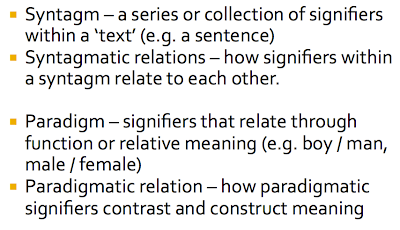Bibliography for essay
Archive for January 2013
Context of Practice - Essay Bibliography
Monday 28 January 2013
by Andrea Hannah Cooper
Categories:
Context of Practice 2,
Essay,
OUGD501
|
Leave a comment
Lecture Notes - Globalisation, Sustainability & the Media
- friendliness and sociality of the village should come along with this idea and make us more aware of ourselves and others
- global resistance to this spread - anti capitalist protestors
- this system is attempting to assimilate people, rather than to bring them together
- corporations are multinational, so unaccountable to any form of politics
- no control of system
- changing the way people think by forcing politics and culture on other people
- product of globalisation
Oligopolies
- giant multinational corporations, who own smaller corporations, and so on
- analysing media bias
- news is basically an elaborate system designed to indoctrinate us into a new system
Thursday 24 January 2013
by Andrea Hannah Cooper
Categories:
Context of Practice 2,
Lecture Notes,
OUGD501
|
Leave a comment
Design For Print & Web - Typography Exhibitions
Another look at the use of space and layout in exhibitions
- with a focus on typographic exhibitions
History of Typography Exhibit
This exhibition space cleverly uses the white space with the contrasting dark works on display draws attention to the work in a very sleek way without it being uninteresting. This style however wouldn't work for my proposal as I am looking at how type is being used within different environments.
'Standard Deviations' Typography Exhibition MoMa | Midtown NYC | photo - Marika Järv
Friday 18 January 2013
by Andrea Hannah Cooper
Categories:
Design For Print and Web,
Design Production,
OUGD504
|
Leave a comment
Design For Print & Web - Exhibition Design
Life sized typographical installation using thousands of pieces of paper folded and glued together to form the sentence that describes and illustrates the concept. The topographic shape transitions from the still nature of paper to the mountaneous organic structure, while keeping its geometric character.
The idea started on paper, with sketches and concepts that were translated to the final design on the computer, to the final 3d shape, back to paper. Building the gigantic sculpture was pretty intense and we wouldn’t have been able to do it without the help of all the friends who kindly lent a hand, for which we are very grateful.
Exhibited in the FOFA Gallery hallway-vitrine for the Concordia University Design Department End of Year exhibition, during the Montréal Design Portes Ouvertes 2010. Published in Communication Arts Typography Annual 2011.
Thursday 10 January 2013
by Andrea Hannah Cooper
Categories:
Design For Print and Web,
Design Production,
OUGD504
|
Leave a comment
Design For Print & Web - Exhibition Design
Looking into how an exhibition is design and proposed
Since the crit yesterday, I have decided to give my work for this brief more of a purpose by proposing an exhibition that the work I have done so far is supporting work and advertising for the exhibition, so looking into how an exhibition functions and is designed.
Looking at exhibitions and exhibition design:
http://en.wikipedia.org/wiki/Exhibit_design
Exhibit design (or exhibition design) is the process of developing an exhibit—from a concept through to a physical, three-dimensional exhibition. It is a continually evolving field, drawing on innovative, creative and practical solutions to the challenge of developing communicative environments that ‘tell a story’ in a three-dimensional space.
- the point about an exhibition telling a story is an interesting one - the exhibition I am proposing isn't so much to tell a story, but rather to introduce a concept which is well known to most people in the world, yet goes fairly unrecognised. I'm looking at how type and typography works build up an environment, become the focus point of an environment or where the environment creates the typography.
Exhibit design is a collaborative process, integrating the disciplines of architecture, landscape architecture, graphic design, audiovisual engineering, digital media,lighting, interior design and content development to develop an audience experience that interprets information, involves and engages a user and influences their understanding of a subject. Throughout the planning and design process, exhibit designers work closely with graphic designers, content specialists, architects, fabricators, technical specialists, audiovisual experts, and, in the case of museums and other mission-based institutions, stakeholders like community members, government agencies and other partner organizations.
- this bit raises the point that exhibition design is an extreme collaborative process. It envolves pitching the idea to the gallery space team, and after getting the go ahead, it requires the work of different groups of people to actually put the exhibition together. For my exhibition proposal I'm planning on simply creating a fictional exhibition and putting together rough designs of how it would work by myself.
The exhibit design process builds on a conceptual or interpretive plan for an exhibit, determining the most effective, engaging and appropriate methods of communicating a message or telling a story. The process will often mirror the architectural process or schedule, moving from conceptual plan, through schematic design, design development, contract document, fabrication and installation. The first phases establish a thematic direction and develop creative and appropriate design solutions to achieve the interpretive and communication goals of the exhibit. The latter phases employ technical expertise in translating the visual language of the designs into detailed documents that provide all the specifications required to fabricate and install an exhibit.
- as stated here, my exhibition will also heavily revolve around the space in which it is proposed. The idea of showcasing typography in different environments is reinforced by actually placing type on the walls and in different parts of the gallery space, as well as including photographs of different pieces of architectural typography.
by Andrea Hannah Cooper
Categories:
Design For Print and Web,
Design Production,
OUGD504
|
Leave a comment
Lecture Notes - Communication Theory
by Andrea Hannah Cooper
Categories:
Context of Practice 2,
Lecture Notes,
OUGD501
|
Leave a comment






















































































